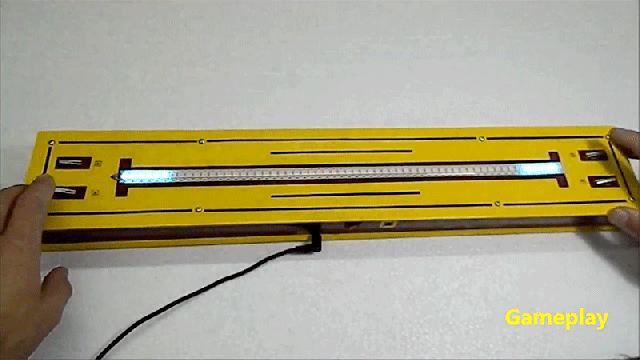Forty-eight years after its debut, despite its antiquated two-dimensional graphics and gameplay, Pong remains a fun and challenging video game. But what happens when you strip it down to just a single dimension? Mirko Pavleski still managed to come up with a way to make 1D Pong a challenge when battling someone head to head.
In a time when 3D graphics dominate gaming you’d think that a simple black and white game with blocky graphics limited to just two dimensions would be a borefest, but the simplicity of Pong remains a big part of its appeal to this day. Even if you’ve mastered Fortnite, getting your paddle precisely into position to return a shot in Pong can still be an act of frustration, despite the paddle only moving back and forth along a straight line. It’s a simple game, but one that can be further simplified as Mirko Pavleski has done with 1D Pong.
The electronics powering 1D Pong are a lot simpler than even the original arcade game since a CRT television isn’t needed nor are spinning controllers because the updated version doesn’t have moving paddles. An Arduino Nano serves as the game’s brains while an Adafruit NeoPixel light strip with 60 colour-changing LEDs serves as the display. Instead of having to accurately predict the ever-changing trajectory of the ball as it bounces off paddles, 1D Pong varies the speed of the ball after every bounce so the game doesn’t get into a predictable cadence, although gameplay slowly speeds up as the back-and-forth progresses.
Players press one of two buttons on each side to make their returns and to add more of a challenge to 1D Pong the farther the ball travels into each player’s blue zone, the faster the bounce back will be, but that also comes with the added risk of missing a shot altogether. One of the two buttons each player uses also activates a speed boost for a faster return, but at the cost of their hit-back zone — the small section of LEDs on either end where a return must be made — getting smaller and smaller.
Like the original Pong, 1D Pong leverages its simplicity as its strength. It’s still a game that’s won or lost based on each player’s reaction times but Pavleski has come up with some genuinely clever ways to add complexity and nuance despite being limited to just a line of glowing dots.
